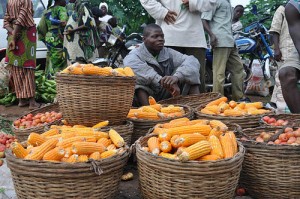
Perspective: Tunji Adenola

Pastor Tunji Adenola is the current National President of the Maize Association of Nigeria (MAAN). He cultivates maize and coordinates activities relating to the maize value chain in the country. In this interview with Femi Ibirogba, he X-rays the challenges in crop production and the way forward. This interview was originally published in the Nigerian Tribune.
Now, how will you describe the level of maize production in Nigeria?
As of today, I can tell you clearly without mincing words that the level has grown in term of productivity and that means the production per unit area has increased. Some years ago, we have only about one tonne per hectare, just about ten bags from one hectare, but today we can talk of 20 to 25 bags and for those who follow production instructions correctly, they can have 30 bags, which are equal to three tonnes per hectare, which is reasonable. In term of volume of total production, the level of production has gone up over time. We could not have more than three million to four million tonnes for the whole country in the past. Today, we can talk of nine million tonnes and that is a big shift from where we were.
With that increase in production, some major maize users like major feed millers in Nigeria still import maize as well as some other materials. Is the imported one cheaper or what is actually responsible?
It is true that some still imports. One of the reasons they import is that they find maize cheaper from some countries like America, where the government heavily subsidizes the production of maize and by the time they bring maize to Nigeria, it is relatively cheaper than what it costs the farmers to produce in Nigeria. So, they tend to go for that. This is possible because America has a higher level of technology; their productivity is higher. When we are talking about 2.5 tonnes, they talk about 5.6 tonnes per hectare and even more in some cases. So, it costs the farmers in America less to produce a tonne of maize than Nigeria because of the high level of subsidy that they give to keep their farmers in business.
So what is your association doing to help farmers with appropriate technologies and are you also working on the subsidy aspect of it?
As a country that is growing, you don’t get to the peak of your technology in one day. The research is giving us now the materials that can increase the yield of farmers, but then the level of education and practices of farmers are not good enough to produce at the level the research is producing. Therefore, usually when the research says you can get five tonnes, our farmers are still getting two. So, it takes good management practices for the farmers to be able to operate at the level very close to research results. So, they are not yet able to get to that level. That is on the side of the farmers. On the side of the government, the level of subsidy is not enough. We are happy with the current Minister of Agriculture on the way he is handling the agricultural sector, because he is making inputs to get to some farmers through the Growth Enhancement Scheme (GES), but the level of that subsidy is targeted at very small farmers, very small scale farmers; people with one hectare or two hectares. If we want to step-change the current level of productivity and production in Nigeria, we need to take care of large-scale, small-scale and medium-scale farmers so that every farmer at every level will enjoy maximum support in supply of seeds, fertiliser, agro-chemicals and equipment so that production becomes a lot more easier, less of drudgery and adequate fertilizer use. If I weed my own once, and this one weeds his own two times, it means all the seeds given to that one will produce a better result. So, the level of management is still very crucial.
Our farmers are old. Some of them are not even educated. So, they still rely solely on what they are used to, but the level of support expected from the government is still very low. Farms that get input support now are the real small farmers (owners of between less than one hectare and two hectares).
Maize is a crop consumed by both animals and humans, so what are researchers doing to reduce the competition for maize?
There is no need to find alternatives for animals. What we will encourage is that the farmers should produce enough so that we can satisfy the livestock industry and satisfy the human consumption. It is not a serious competition; it is just a conversion of carbohydrate to protein. You convert your grains to meat, to fish, to protein and you eat. So, there is no need to look for alternative. Nigeria has the potential to meet all its needs for maize locally. What we really need is to step-change the level of production.
Cassava has been bio-fortified with vitamin A and some other crops are being bio-fortified. Is maize undergoing the same thing for the purpose of reducing malnutrition?
Cassava and maize are not in the same category when it comes to nutrients. Cassava is just essentially starch (carbohydrate), but maize has reasonable levels of essential nutrients human needs in terms of vitamins, minerals and starch. So, if you eat maize, you get a balanced meal. So, it does not require any fortification but what we are trying to do is that research is introducing some more varieties that are richer in protein more than the ones that go to the livestock. So you have varieties which are high in protein but the current maize we use is okay. It does not bring malnutrition. For example, yellow maize is better than white nutritionally. They all have certain qualities that make them better.
In what way has maize production improved the standard of farmers in Nigeria?
I want to tell you today that maize is a cash crop generating billions of naira, in fact dollars. In the past, it used to be just boil, cook and make pap. Today, it has gone to the industrial level: livestock feeds, the starch industry, and in fact, maize produces higher quality starch better than cassava, and maize is more efficient. If you process one hundred tonnes of cassava, eighty per cent of it is water. In the case of maize, it is mainly dry matter. So, if you process one hundred tonnes of maize, you are sure you are going to have 98 or 90 per cent of pure dry matter instead of the water you are carrying with the cassava. So, when you put naira value on maize today in Nigeria, there is hardly any other crop that can beat it, not even cocoa. When we started the project on maize in IITA in 1984 and we get to the level of hybrid maize, maize was not in the North seriously; it was in the South, but by the time we discovered that the weather in the North is far better for the production of maize, the base of maize production in Nigeria moved to the North. So, maize today is contributing a lot to the economy of Nigeria.
Now, what is your administration doing to help the Federal Government in realising its goal in ATA as well as helping farmers to get better varieties of maize for planting?
I told you earlier that researchers and extension workers are our members. So, the varieties that go to the farmers are determined mainly by our members that are in research. When we do the trials across Nigeria, we pick the best ones for each region and then we say this one should go to this region or that. So, as an association, we work very close in collaboration with the whole system. We know the variety that goes to any particular region; we also advise because some of our members are extension workers teaching farmers how to produce and manage farms. You get the seed companies that are producing the seeds to test their materials in different areas so the farmer can see what he is doing against the new materials that are coming and I am sure once you do something that is better, you know it. So, they can pick that this one is better than what they have been doing. So, it is easy to convince them to use the new materials.
So, you are involved in ATA?
We are fully in it. In fact, the Maize Association of Nigeria has been mandated to produce some of seeds that will be given to farmers next year, because the seed companies could not produce enough last year and the Honourable Minister requested our association to help to produce some high quality seeds.
 Are you telling the youth and the unemployed to go into maize production?
Are you telling the youth and the unemployed to go into maize production?
In fact, it will pay them to do so. When you look at what it costs to produce maize seeds, if a young graduate is producing maize for example, he is going to sell a kilo of seeds at about N120. So, if you produce a tonne, you will get N120,000 for the tonne. So, those who are educated and young, what we will train them to do is to produce seeds so that they can see it is profitable. When they make some money, they have large farms, then they can produce grains at the level they will make money. So, maize production in Nigeria today is a big business, a very big business and you can get a lot of money. The area the maize association has not been able to make impact is in getting the government to do what we want. The government is saying there is no money because it cannot put the proper support in place. Like I said, this new minister is doing well.
He is going in the right direction, but it is not enough.
